It’s a wheel! It’s a wheel – a wheel on Mars!
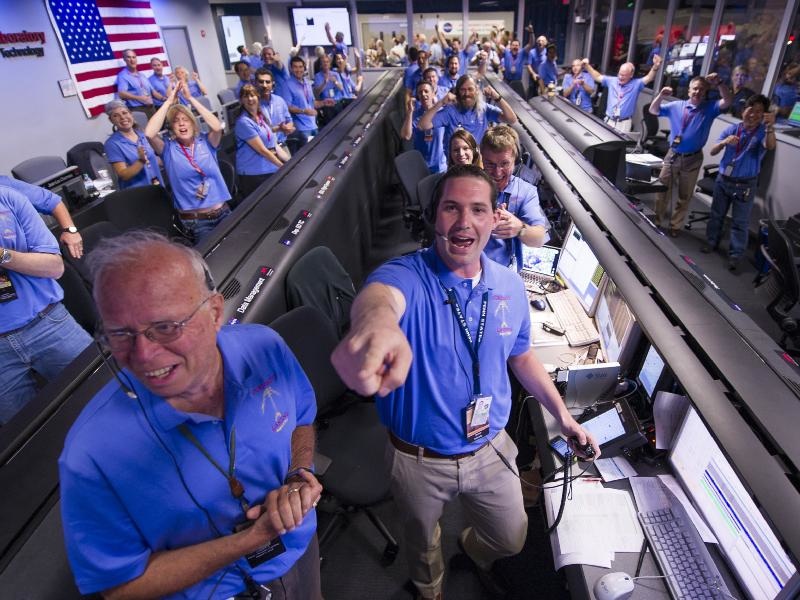
NASA’s rover Curiosity was safely on Mars. It was a perfect landing. The novel sky-crane method had proved its detractors wrong and its designers right. What was needed then was signs that Curiosity was working as designed. NASA had said that the first pictures may be anything up to 2 hours after landing. A long time for the audiences, waiting, live, all over Earth.

“Got thumbnails.” Pause in the control centre, then someone else yells “Its a wheel, its a wheel!” “A wheel on Mars!” For the second time that momentous afternoon the NASA/Jet propulsion Lab crowd erupted into spontaneous and joyful applause. Not only had they landed the rover, Curiosity, safely on Mars, they had received the first images back from its cameras. Sometimes the unscripted, unexpurgated exclamations make for the best history.
The first two pictures were from the front and back navigation cameras. They were low resolution black and white thumbnails taken through the dust caps that protected the cameras during landing. As the minutes ticked by higher resolution images came through from the rover. The business as usual, familiar image enhancement bought into sharp clarity the ‘first’ two images from the robot explorer.
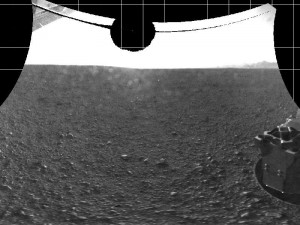
The first week on Mars
After the exuberance and press conference came the trademark NASA precision and methodical approach. An approach that gets missions safely to Mars, at the same time can make the audacious appear mundane.
Mission controllers at NASA’s Jet Propulsion Laboratory in Pasadena, are now checking out Curiosity’s subsystems and 10 instruments. Curiosity is in the opening days of a two-year mission to investigate whether conditions have been favorable for microbial life and preserving clues in the rocks about possible past life.
Mission team members are “living” on Mars time. A Martian day is approximately 40 minutes longer than an Earth day, meaning team members start their shift 40 minutes later each day.
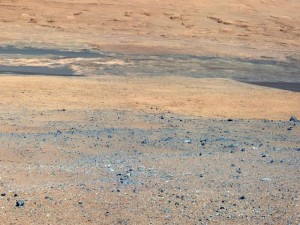
Amongst the important system events in this first week was a software upgrade. It took four days to successfully upgrade Curiosity’s software in its main and back-up computer. The software had been uploaded during its trek to Mars, but not activated until now. The software to date was focused on getting Curiosity through the Martian atmosphere and safely to its destination in Gale Crater. The software upgrade is to cover its surface exploration activity, roving and controlling the various scientific instruments.
Curiosity Ready to Roll
“There will be a lot of important firsts that will be taking place for Curiosity over the next few weeks, but the first motion of its wheels, the first time our roving laboratory on Mars does some actual roving, that will be something special,” said Michael Watkins, mission manager for Curiosity from the Jet Propulsion Laboratory.
Mission engineers are devoting more time to planning the first rove of Curiosity. In the coming days, the rover will exercise each of its four steerable (front and back) wheels, turning each of them side-to-side before ending up with each wheel pointing straight ahead. On a later day, the rover will drive forward about one rover-length 3 metres, turn 90 degrees, and then kick into reverse for about 2 metres. Exciting times for the rover driver team!
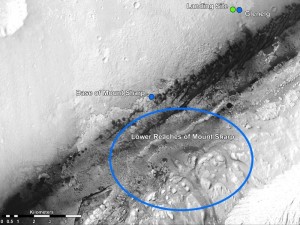
The scientists and engineers of NASA’s Curiosity rover mission have selected the first driving destination for Curiosity. The target area, named Glenelg, is a natural intersection of three kinds of terrain. The trek to Glenelg will send the rover 400 metres east-southeast of its landing site. One of the three types of terrain intersecting at Glenelg is layered bedrock, which is attractive as the first drilling target.
The choice described by Curiosity Principal Investigator John Grotzinger of the California Institute of Technology as, “With such a great landing spot in Gale Crater, we literally had every degree of the compass to choose from for our first drive.” “We had a bunch of strong contenders. It is the kind of dilemma planetary scientists dream of, but you can only go one place for the first drilling for a rock sample on Mars. That first drilling will be a huge moment in the history of Mars exploration.”
Grotzinger estimated the rover’s journey would take between three weeks and two months to arrive at Glenelg, where it will stay for roughly a month before heading to the base of Mount Sharp.
It may be a full year before the remote-controlled rover gets to the base of the peak, which is within 20 kilometres of the rover’s landing site.
Zapping rocks and doing science
Before Curiosity heads off to Glenelg another first will occur. The team in charge of Curiosity’s Chemistry and Camera instrument, is planning to give their mast-mounted, rock-zapping laser and telescope combination a thorough checkout. ChemCam has “zapped” its first rock in the name of planetary science. It was the first time such a powerful laser has been used on the surface of another world.
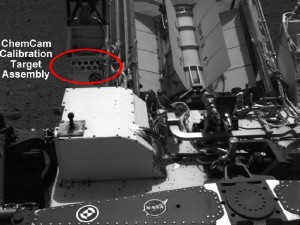
The technique is called ‘laser-induced breakdown spectroscopy’. The high-powered, narrow-focused, laser beam vaporises the rock from a distance generating a plasma plume with temperatures in excess of 100,000°C. At the high temperatures during the early plasma, the vaporised material breaks down into excited ionic and atomic species. As it cools to 5,000–20,000°C the characteristic atomic emission lines of the elements can be recorded by the camera. This data is compared to the ‘standards’ that the rover carries to identify the rock components.

As Roger Wiens, principal investigator of the ChemCam instrument from the Los Alamos National Laboratory explained earlier, “Rock N165 looks like your typical Mars rock, about three inches wide. It’s about 10 feet away.” “We are going to hit it with 14 millijoules of energy 30 times in 10 seconds. It is not only going to be an excellent test of our system, it should be pretty cool too.”
Pretty cool indeed.
First weather report in 30 years
It is currently just above freezing point in gale Crater where Curiosity is.
Grotzinger noted the team’s report on the Martian crater’s temperature was “really an important benchmark for Mars science”.
“It’s been exactly 30 years since the last long duration monitoring weather station was present on Mars,” when Viking 1 stopped communicating with Earth in 1982,” he said. Then Viking 1 lander recorded temperatures that varied from −17.2 °C to −107 °C.
Sensors on two finger-like mini-booms extending horizontally from the mast of NASA’s Mars rover Curiosity will monitor wind speed, wind direction and air temperature. One also will monitor humidity; the other also will monitor ground temperature. The sensors are part of the Rover Environmental Monitoring Station, provided by Spain for the Mars Science Laboratory mission.
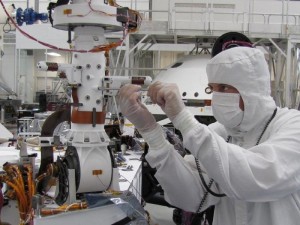
In this image, the spacecraft specialist’s hands are just below one of the Rover Environmental Monitoring Station mini-booms. The other mini-boom extends to the left a little farther up the mast.
As Curiosity’s primary mission is for a full Martian year it will be able to record the seasonal variations that occur for Mars.
On the ground radiation monitoring and weather conditions will be crucial for any future exploration or habitation by humans. This mission by Curiosity represents an important step towards these aspirations.
 Follow
Follow
In true social media fashion the ‘zapped’ rock now has an alias “Coronation” and its own twitter handle: @N165Mars, check it out; a rock with a sense of humour to boot!
It’s just a flesh wound! http://photojournal.jpl.nasa.gov/catalog/PIA16075 … (It still wasn’t very nice though.)